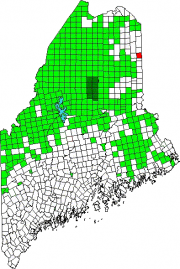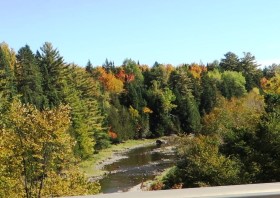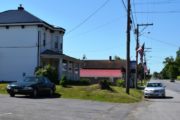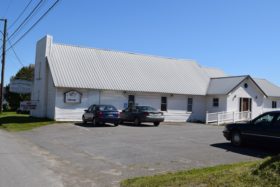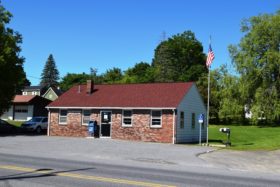| Year | Population |
|---|---|
| 1970 | 1,072 |
| 1980 | 950 |
| 1990 | 872 |
| 2000 | 790 |
| 2010 | 790 |
| Geographic Data | |
|---|---|
| N. Latitude | 46:19:43 |
| W. Longitude | 67:50:51 |
| Maine House | District 145 |
| Maine Senate | District 34 |
| Congress | District 2 |
| Area sq. mi. | (total) 38.3 |
| Area sq. mi. | (land) 38.2 |
| Population/sq.mi. | (land) 20.7 |
County: Aroostook
Total=land+water; Land=land only |
|
[mon-tih-SEL-low] is a town in Aroostook County, settled in 1830 and incorporated on July 29, 1846 from Monticello Plantation.
Originally known as Wellington Plantation for its first owner, General Joel Wellington of Albion, the name was changed on incorporation in honor of President Thomas Jefferson’s estate.
The town’s has economy has traditionally been based on agriculture, especially potatoes, but also hay and oats in the 19th century. The Grange had a vital role.
With the decline of potato farming, Monticello’s population has shrunk over the past forty years, but the process has slowed, at least for now.
The long winding Meduxekeag River has its origins west of Houlton. Its north branch flows through Monticello before exiting to Canada on its eastern border.
Located about twelve miles north of Houlton, Monticello was first linked to that town when a road was cut in 1833. Now, U.S. Route 1 provides that link though the surrounding potato growing countryside.
Form of Government:
Town Meeting-Select Board-Manager.
Additional resources
Michaud, Clair. [Folklore: Tall Tales; Devil Story; Witch Story; Ghost; Jokes; Forerunners; Folk Hero George Knox; Marchen; Song “The blacksmith’s little boy”] Orono, Me. The Author. 1962. (Cataloger Note: Fieldwork done throughout southern Aroostook County, primarily in Monticello, Maine.) [University of Maine at Presque Isle. Library and Learning Resource Center.]
Monticello’s Centennial, 1846-1946. 1946? [University of Maine at Presque Isle. Library and Learning Resource Center.]
Stackpole, Lucien E. Notes and Incidents in the Early Settlement of Monticello. Monticello, Me. Bicentennial Committee. 1976.
Stevens, Gifford. Interview with Lawrence Carmichael, farmer and fiddle maker, about how a fiddle is made. Sound recording. Bradley, Me. The Author. 1980.
National Register of Historic Places – Listings
Monticello Grange #338
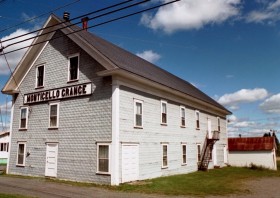 [Main Street, 0.7 miles south of junction with Muckatee Road] Built in 1922 to replace the original hall that burned the previous year, the Monticello Grange #338 is a large two-story frame building along US Route 1 in Monticello village. Like many similar buildings in small Maine towns, this virtually unaltered grange hall was a focal point for community activities. Monticello Grange #338 was founded in 1899, at which time its members began the construction of a large hall.
[Main Street, 0.7 miles south of junction with Muckatee Road] Built in 1922 to replace the original hall that burned the previous year, the Monticello Grange #338 is a large two-story frame building along US Route 1 in Monticello village. Like many similar buildings in small Maine towns, this virtually unaltered grange hall was a focal point for community activities. Monticello Grange #338 was founded in 1899, at which time its members began the construction of a large hall.
In 1921 the original grange building in Monticello was destroyed by fire, and the present hall was erected in place. The new grange hall is somewhat narrower but substantially longer than its predecessor. The overall appearance of this hall resembles buildings that could have been built in the late 19th century, but it differs from them in the use of decorative tin sheathing (both on the exterior and interior) apparently to reduce any future fire hazard.
Until a new fire department/town office was built in 1980, the grange hall was used for town meetings and contained the town offices. It also had the only stage in Monticello until a new multi-purpose room was added to the local school in 1974. Prior to that all school plays, musical productions and shows, as well as graduation ceremonies and other community events were held in Grange Hall.*



